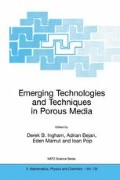Abstract
One of the many topics of scientific interest in the Department of Refrigeration Machines at the Odessa State Academy of Refrigeration (OSAR) is the adaptation of modern methods of applied thermodynamics for the analysis and optimization of machines working in inverse thermodynamic cycles.
Access this chapter
Tax calculation will be finalised at checkout
Purchases are for personal use only
Preview
Unable to display preview. Download preview PDF.
References
Auracher, H. (1981). Effective thermal conductivity of frost. Seminar on advancement in heat exchangers, Dubrovnik.
Bejan, A. (1982). Entropy generation through heat and fluid flow. Wiley, New York.
Bejan, A. (1995). Entropy generation minimization in heat transfer. In Second law analysis of energy systems: toward the 21st century (ed. E. Sciubba and M. Moran), pp. 363-72. Proceedings of international conference ROMA.
Bejan, A., Tsatsaronis, G. and Moran, M. (1996). Thermal design and optimization. Wiley, New York.
De Olivera, S., Schwarzer, B., LeGoff, P. and Tondeur, D. (1991). Comparison of the entropie, exergetic and economic optima of a heat exchanger. In Analysis of thermal and energy systems (ed. D. Kouremenos, G. Tsatsaronis and C. Rakopoulos), pp. 105-16. Proceedings of international conference ATHENS′91.
Fraas, A. and Özisik, M. N. (1971). Heat exchanger design. Wiley, Atomizdat, Moscow. In Russian.
Nikulshin, R. (1989). Experimental research of heat exchange process in rollingwelded evaporators with compelled movement of air. Refrig. Technique Tech., 48, 57–9.
Refrigeration engineering encyclopedia (1960). Gostorgizdat, Moscow.
Reznikov, L. (1987). Perfection of processes and apparatuses of gasification systems of high pressure cryogenic products. PhD thesis. Odessa State Academy of Refrigeration, Odessa.
Robert, L. and Feidt, M. (2000). Optimisation dynamique du comportement d’un échanger de chaleur soumis au phénomène d’encrassement. Entropie, 226, 28–36.
Rosenfeld, L. and Tkahev, A. (1960). Refrigeration machines and apparatuses. Gostorgizdat, Moscow.
Schaal, L. and Feidt, M. (1999). Optimization of the dynamic behavior of a heat exchanger subject to fouling compaison of three optimization models. Int. J. Appl Thermodyn., 2, 89–96.
Shamray, A. (1993). Choice of optimal composition of oil and ozone-saving refrigerants for refrigeration machines. PhD thesis. Odessa State Academy of Refrigeration, Odessa.
Tchuklin, S. G. and Thepurnenco, V. P. (1975). Development and research of new methods, apparatuses and cooling systems for optimal conditions of a products storage. Technical Report. Odessa State Academy of Refrigeration, Odessa.
Author information
Authors and Affiliations
Editor information
Editors and Affiliations
Rights and permissions
Copyright information
© 2004 Springer Science+Business Media Dordrecht
About this paper
Cite this paper
Morosuk, T.V. (2004). Porous Media Theory as Basis for Model of Fouling Layers Formation in Heat Exchangers. In: Ingham, D.B., Bejan, A., Mamut, E., Pop, I. (eds) Emerging Technologies and Techniques in Porous Media. NATO Science Series, vol 134. Springer, Dordrecht. https://doi.org/10.1007/978-94-007-0971-3_32
Download citation
DOI: https://doi.org/10.1007/978-94-007-0971-3_32
Publisher Name: Springer, Dordrecht
Print ISBN: 978-1-4020-1874-9
Online ISBN: 978-94-007-0971-3
eBook Packages: Springer Book Archive

